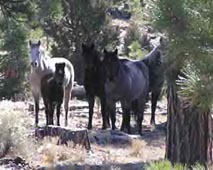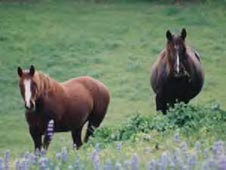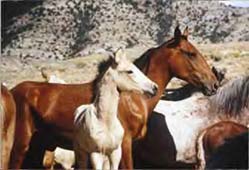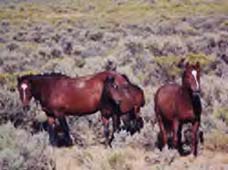| EQUINETOURISM - WORLDWIDE - Wild Horse Preservation USA |
Preserving the Wild Horses of America |
|
Wild Horses are American Icons - The American Wild Horse Preservation Campaign is dedicated to preserving the American wild horse in viable free-roaming herds for generations to come, as part of America's national heritage. Here we explore America's wild horse history.
For more information visit www.wildhorsepreservation.com |
| |
| Mestengo. Mustang. Misfit. America’s Disappearing Wild Horses |
By Laura Moretti
Fifty million years ago, a small dog-like creature called Eohippus evolved on the North American continent. In fact, this forerunner to the modern horse was traced to the Tennessee Valley. After evolving into Equus and disappearing into Asia and Africa presumably 8 to 10 thousand years ago, the horse returned to our soil with the Spanish in the early 1500s. From their hands, a few escaped onto the American canvas.
It is believed that the horse is the only domesticated animal capable of reverting to a wild state. It did so 500 years ago in North America, and, according to Western writer J. Frank Dobie, its numbers in the 19th century reached more than 2 million. But by the time the wild horse received federal protection in 1971, it was officially estimated that only about 17,000 of them roamed America’s plains. More than 1 million had been conscripted for World War I combat; the rest had been hunted for their flesh, for the chicken feed and dog food companies, and for the sport of it. They were chased by helicopters and sprayed with buckshot; they were run down with motorized vehicles and, deathly exhausted, weighted with tires so they could be easily picked up by rendering trucks. They were run off cliffs, gunned down at full gallop, shot in corralled bloodbaths, and buried in mass graves.
Like the bison, the wild horse had been driven to the edge. Enter Velma Johnston, a.k.a. “Wild Horse Annie.” After seeing blood coming from a livestock truck, she followed it to a rendering plant and discovered how America’s wild horses were being pipelined out of the West. Her crusade led to the passage of a 1959 law that banned the use of motorized vehicles and aircraft to capture wild horses. In the end, it was public outcry that ended the open-faced carnage—and it came from the nation’s schoolchildren and their mothers: in 1971, more letters poured into Congress over the plight of wild horses than any other non-war issue in U.S. history; there wasn’t a single dissenting vote, and one congressman alone reported receiving 14,000 letters. President Nixon signed the bill into law on December 15, 1971. And so the Wild Free-Roaming Horse & Burro Act was passed, declaring that “wild horses and burros are living symbols of the historic and pioneer spirit of the West; that they contribute to the diversity of life forms within the Nation and enrich the lives of the American people; and that these horses and burros are fast disappearing from the American scene.” The Act was later amended by the Federal Land Policy and Management Act of 1976 and the Public Rangelands Improvement Act of 1978.
By the people, of the people, for the people. There has never been a truer case. Wild Horse Annie’s 1959 legislation allowed the mustang (from the Spanish word mestengo, or “stray beast”) to get a desperate foothold in the American West. Wild horse numbers grew and consequently encouraged the wrath of ranchers who enjoy subsidized grazing for their cattle on the public domain. The Bureau of Land Management (BLM) and the U.S. Forest Service were appointed to implement the 1971 Act (most herd areas are under BLM jurisdiction). Their responsibilities also include issuing public land grazing permits to cattle ranchers. It is a war as old as the West itself. What is useful is used, what is not is destroyed—with contempt. In a mechanized world, not even the cattle industry has a need for living horsepower.
|




|
| Frequently Asked Questions About Wild Horses |
Q: Where are America’s remaining wild horses and burros?
A: Today, wild horses and burros can be found primarily on government-designated Herd Management Areas (HMAs) in ten western states: Arizona, California, Colorado, Idaho, Montana, Nevada, New Mexico, Oregon, Utah and Wyoming. Six states have already lost their entire wild horse populations.

Q: Is there an overpopulation of wild horses on public lands?
A: Wild horses comprise a minute fraction of grazing animals on public lands, where they are outnumbered by cattle at least 100 to 1. The 1971 Act states that, in a given area, a certain amount of vegetation may be eaten as forage. Only when that amount is exceeded are there too many animals. The Bureau of Land Management (BLM) has overwhelmingly favored cattle in setting “appropriate” wild horse population levels, resulting in indiscriminate removal of horses and burros from public lands. From over 2 million in 1900, our wild horse population has dwindled to less than 25,000.
Q: Aren’t wild horses suffering from drought and starvation out on the range?
A: Mismanagement is at the root of most of these problems. Despite federal protection, wild horses have been relegated to the most inhospitable areas of the range. Still, they have adapted and survived; most horses rounded up by the BLM are well-fed and healthy. However, public land fencing often prevents horses from accessing scarce natural water sources and disrupts their widespread grazing patterns. In such instances, better in-the-wild management is the answer, rather than costly and traumatic round-ups.
Q: Are wild horses responsible for overgrazing on public lands?
A: The main cause of degradation of public lands is livestock use, not wild horses. Cows graze within a mile of water, while wild horses are highly mobile, grazing from five to ten miles from water, at higher elevations, on steeper slopes, and in more rugged terrain. A congressionally-mandated study by the National Academy of Sciences found that, in one year, livestock consumed 70% of grazing resources on public lands, while wild horses and burros consumed less than 5%.
Q: Is it true that wild horse herds double in size every five years and have no natural predators?
A: In its 1982 study, the National Academy of Sciences found “annual rates of increase of 10% or less” in wild horse populations. Wild horses do have predators, in the form of mountain lions and bears. In 2004 for instance, only 1 out of 28 foals survived in Montana’s Pryor Mountain area. Such low survival rate was mostly due to mountain lion predation.
Q: Aren't wild horses a non-native species?
A: Wild horses are a reintroduced native wildlife species. Paleontological evidence shows that wild horses evolved on the North American continent over the course of some 1.6 million years. How they disappeared 11 to 13 thousand years ago, if in fact they actually ever became extinct here, is a mystery. When Cortez landed in Mexico in 1519, he brought horses from Spain. Others followed. From these reintroduced animals came the great numbers of wild horses that eventually changed the culture of the Plains Indians. The Spanish horses soon adapted to the same ecological niche their native relatives had once thrived in. Long before the early settlers pioneered the West, they were here as a reintroduced, fully adapted wildlife species, 3 million strong.
Q: But isn't the modern horse species a different one from the one that disappeared so long ago?
A: Most of those early differing species were genetically equivalent. Modern molecular biology, using mitochondrial DNA analysis, has shown that the genetic equivalent of Equus caballus emerged, diverged as a species, about 1.6 million years ago, disappearing from the North American continent presumably 11 to 13 thousand years ago. Even more recent molecular work has shown that the very latest the modern horse could possibly have diverged was about 300,000 years ago. For a detailed review of these recent findings, please check Wild Horses as Native North American Wildlife.

Q: How are wild horses different from domestic horses?
A: The result of five hundred years of natural selection, the American wild horse distinguishes itself from domesticated horses by both its morphology and its behavior. Natural selection has preserved the hardy traits of the horses that shaped the American West: a 1998 Kansas State University study found that wild horses are far less affected by bone disease than their domestic counterparts; wild horses also distinguish themselves by the remarkable hardness of their hooves. In addition, a University of Kentucky study has shown that, despite intense culling, wild horse herds are still genetically far more diverse than any breed of domestic horse. Some herds such as Utah’s Sulphur Spring herd are a direct link to the primitive Iberian horse and have been recognized by geneticists as a resource of “truly unique and irreplaceable genotypes, a zoological treasure.” These horses retain many traits of the endangered Sorraia breed, including triple dorsal stripes, zebra striped legs, and chest barring.
Q: What about burros?
A: Wild burros’ situation is even more precarious than that of their wild horse cousins. Their population has dwindled to less than 5,000 and BLM’s population target is set below 3,000 nationally. During the late 1800s, miners used burros as pack animals while prospecting for gold and silver. Their descendants can still be found in Nevada, Arizona and California. Under the National Park Service’s zero wild burro policy, burros are routinely shot in an eradication program labelled “direct reduction.” Over 400 burros have been shot to death in California’s Death Valley. AWHPC’s dedication to preserving the American wild horse extends to America’s wild burros as well.

The Wild Free-Roaming Horse and Burro Act recognizes the wild horse as an "integral component of the natural system." It stipulates that horses can only be removed from public lands if it is proven that they are overpopulating or are causing habitat destruction. It further mandates that the government "maintain specific ranges on public lands as sanctuaries for their protection and preservation." |
Wild Horses as Native North American Wildlife
|
By Jay F. Kirkpatrick, Ph.D. and Patricia M. Fazio, Ph.D.*
Are wild horses truly “wild,” as an indigenous species in North America, or are they “feral” weeds – barnyard escapees, far removed genetically from their prehistoric ancestors? The question at hand is, therefore, whether or not modern horses, Equus caballus, should be considered native wildlife. The genus Equus, which includes modern horses, zebras, and asses, is the only surviving genus in a once diverse family of horses that included 27 genera. The precise date of origin for the genus Equus is unknown, but evidence documents the dispersal of Equus from North America to Eurasia approximately 2-3 million years ago and a possible origin at about 3.4-3.9 million years ago.
Following this original emigration, several extinctions occurred in North America, with additional migrations to Asia (presumably across the Bering Land Bridge), and return migrations back to North America, over time. The last North American extinction occurred between 13,000 and 11,000 years ago.1 Had it not been for previous westward migration, over the land bridge, into northwestern Russia (Siberia) and Asia, the horse would have faced complete extinction. However, Equus survived and spread to all continents of the globe, except Australia and Antarctica.
In 1493, on Columbus’ second voyage to the Americas, Spanish horses, representing E. caballus, were brought back to North America, first in the Virgin Islands, and, in 1519, they were reintroduced on the continent, in modern-day Mexico, from where they radiated throughout the American Great Plains, after escape from their owners.2
Critics of the idea that the North American wild horse is a native animal, using only paleontological data, assert that the species, E. caballus (or the caballoid horse), which was introduced in 1519, was a different species from that which disappeared 13,000 to 11,000 years before. Herein lies the crux of the debate. However, the relatively new (27-year-old) field of molecular biology, using mitochondrial-DNA analysis, has recently found that the modern or caballine horse, E. caballus, is genetically equivalent to E. lambei, a horse, according to fossil records, that represented the most recent Equus species in North America prior to extinction. Not only is E. caballus genetically equivalent to E. lambei, but no evidence exists for the origin of E. caballus anywhere except North America.3
According to the work of Uppsala University researcher Ann Forstén, of the Department of Evolutionary Biology, the date of origin, based on mutation rates for mitochondrial-DNA, for E. caballus, is set at approximately 1.7 million years ago in North America. Now the debate becomes one of whether the older paleontological fossil data or the modern molecular biology data more accurately provide a picture of horse evolution. The older taxonomic methodologies looked at physical form for classifying animals and plants, relying on visual observations of physical characteristics. While earlier taxonomists tried to deal with the subjectivity of choosing characters they felt would adequately describe, and thus group, genera and species, these observations were lacking in precision.
Reclassifications are now taking place, based on the power and objectivity of molecular biology. If one considers primate evolution, for example, the molecular biologists have provided us with a completely different evolutionary pathway for humans, and they have described entirely different relationships with other primates. None of this would have been possible prior to the methodologies now available through mitochondrial-DNA analysis.
Carles Vilà , also of the Department of Evolutionary Biology at Uppsala University, has corroborated Forstén’s work. Vilà et al have shown that the origin of domestic horse lineages was extremely widespread, over time and geography, and supports the existence of the caballoid horse in North
American before its disappearance.4 Finally, the work of Hofreiter et al,5 examining the genetics of the so-called E. lambei from the permafrost of Alaska, found that the variation was within that of modern horses, which translates into E. lambei actually being E. caballus, genetically. The molecular biology evidence is incontrovertible and indisputable.
The fact that horses were domesticated before they were reintroduced matters little from a biological viewpoint. They are the same species that originated here, and whether or not they were domesticated is quite irrelevant. Domestication altered little biology, and we can see that in the phenomenon called “going wild,” where wild horses revert to ancient behavioral patterns. James Dean Feist dubbed this “social conservation” in his paper on behavior patterns and communication in the
Pryor Mountain wild horses. The reemergence of primitive behaviors, resembling those of the plains zebra, indicated to him the shallowness of domestication in horses.6 The issue of feralization and the use of the word “feral” is a human construct that has little biological meaning except in transitory behavior, usually forced on the animal in some manner.
Consider this parallel. E. Przewalski (Mongolian wild horse) disappeared from Mongolia a hundred years ago. It has survived since then in zoos. That is not domestication in the classic sense, but it is captivity, with keepers providing food and veterinarians providing health care. Then they were released a few years back and now repopulate their native range in Mongolia. Are they a reintroduced native species or not? And what is the difference between them and E. caballus in North America, except for the time frame and degree of captivity?
The key element in describing an animal as a native species is (1) where it originated; and (2) whether or not it co-evolved with its habitat. Clearly, E. caballus did both, here in North American. There might be arguments about “breeds,” but there are no scientific grounds for arguments about “species.”
The non-native, feral, and exotic designations given by agencies are not merely reflections of their failure to understand modern science, but also a reflection of their desire to preserve old ways of thinking to keep alive the conflict between a species (wild horses) with no economic value anymore (by law) and the economic value of commercial livestock.
Native status for wild horses would place these animals, under law, within a new category for management considerations. As a form of wildlife, embedded with wildness, ancient behavioral patterns, and the morphology and biology of a sensitive prey species, they may finally be released from the “livestock-gone-loose” appellation.
1"Horse Evolution" by Kathleen Hunt from www.onthenet.com.au/~stear/horse_evolution.htm; Bruce J. MacFadden, Fossil Horses: Systematics, Paleobiology, and Evolution of the Family Equidae (New York: Cambridge University Press, 1992), p. 2052Patricia Mabee Fazio, "The Fight to Save a Memory: Creation of the Pryor Mountain Wild Horse Range (1968) and Evolving Federal Wild Horse Protection through 1971," doctoral dissertation, Texas A&M University, College Station, 1995, p. 21.3Ann Forstén, 1992. Mitochondrial-DNA timetable and the evolution of Equus: Comparison of molecular and paleontological evidence. Ann. Zool. Fennici 28: 301-309.4Carles Vilà , Jennifer A. Leonard, Anders Götherström, Stefan Marklund, Kaj Sandberg, Kerstin Lidén, Robert K. Wayne, Hans Ellegren. 2001. Widespread origins of domestic horse lineages. Science 291: 474-477.5Hofreiter, M., D. Serre, H.N. Poinar, M. Kuch, S. Pääbo, S., 2001. Ancient DNA. Nature 2: 353-359.6James Dean Feist and Dale R. McCullough. 1976. Behavior patterns and communication in feral horses. Z. Tierpsychol. 41: 367*Jay F. Kirkpatrick, Director, The Science and Conservation Center, Billings, Montana, holds a Ph.D. in reproductive physiology from the College of Veterinary Medicine at Cornell University. Patricia M. Fazio is a freelance environmental writer and editor, and holds a B.S. in animal husbandry/biology from Cornell University, an M.S. in environmental history from the University of Wyoming, and a Ph.D. in environmental history from Texas A&M University, College Station. |
| For More information |
Please visit www.wildhorsepreservation.com
Editorial and pictures by kind permission of the Wild Horse Preservation Campaign
CLICK HERE for USA Horse Riding Holidays/ Horseback Vacations |
BACK TO EQUINETOURISM.CO.UK WORLDWIDE HORSE HOLIDAYS FRONT PAGE
|
|
 Horse riding holidays, equestrian events and shows, horseback vacations, equine directory, good horsemanship, horse holidays, uk and worldwide
Â
ADVERTISE on Equinetourism.co.uk - Click here
SEARCH FOR CONTENT ON EQUINETOURISM.CO.UK |
Also see www.EquineTourismCommunity.com and www.EquineTourism.com
email: [email protected] - Telephone 00 44 (0)1643 862785
www.EquineTourism.co.uk is owned by Happy Horses Ltd, Holt Ball, Luccombe, Minehead, Exmoor, Somerset TA24 8SZ
Full worldwide copyright and all rights retained ©2004-2014 ongoing Happy Horses Ltd. Please read our Disclaimer
|
